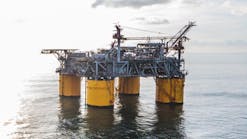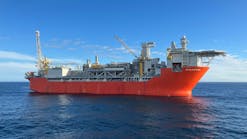Azerbaijan International Operating Co. (AIOC) has signed a transportation agreement that will allow exports of Azeri crude oil to begin reaching world markets about mid-1997.
The agreement with Russia's Transneft oil pipeline company sets a tariff of $15.67/metric ton for shipments of AIOC oil from Azeri, Chirag, and the southern part of Guneshli fields, about 120 miles off Azerbaijan in the Caspian Sea.
Transneft will transport AIOC's crude through a 1,250 km northern route from a point near Baku by way of Tikhoretsk, Russia, to the Russian Black Sea port of Novorossiysk. The northern route main line will consist mostly of a reversed oil pipeline.
Russian and Azerbaijani officials on Jan. 18 in an intergovernmental agreement set the framework under which the oil pipeline could proceed.
Meantime, talks are continuing on a proposed western pipeline route that would transport AIOC crude through Georgia to the Black Sea port of Supsa.
Negotiators also are working on pipeline proposals that would allow exports of Caspian oil to bypass the Black Sea. Those alternatives would avoid increasing oil shipments to the Mediterranean Sea through the environmentally sensitive Bosporus area.
With the transportation agreement with Transneft in place, AIOC Executive Vice Pres. E.R. McHaffie said the multinational group of companies immediately will step up offshore development spending in its three fields, as well as begin work on northern route components. McHaffie unveiled the plan at a mid-February meeting in Houston sponsored by Cambridge Energy Research Associates.
AIOC status
AIOC partners last fall agreed to a $7.95 billion development program for its Caspian Sea tract.
The plan included minimum obligatory spending of $150 million through mid-1997 to appraise the acreage. Activity funded by the appraisal program includes collecting 3D seismic data over the area, surveying the seabed, compiling baseline environmental data, analyzing an existing platform in Chirag field, and evaluating possible export routes for early production from the area.
AIOC also expects to spend an additional $350 million through mid-2000 to refurbish the Chirag platform, equip it for drilling, and drill 20 wells from the structure. With costs of past and future bonuses, operating costs in advance of first production, and general administrative expenses, total early oil phase spending could amount to as much as $1 billion, McHaffie said.
Main development in the three fields is to occur in three phases costing $2.1 billion, $1.85 billion, and $3.5 billion, respectively.
AIOC estimates reserves of its Caspian Sea acreage at about 3.8 billion bbl of oil, Caspian regional reserves at 12 billion bbl, and undiscovered regional resources at another 37 billion bbl.
AIOC expects production from Guneshli, Chirag, and Azeri fields to peak in 2010 at about 700,000 b/d. With other upstream projects advancing around the Caspian, oil volumes from the region over time should be great enough to warrant multiple export pipelines, McHaffie said.
AIOC pipeline
To export oil on the agreed northern route, AIOC plans to bring oil ashore at Sangachal, Azerbaijan, south of Baku through an existing, idle pipeline as far as Guzdek, Azerbaijan. From Guzdek, AIOC will lay a short pipeline to an existing, southbound oil pipeline between Tikhoretsk and Baku. AIOC will reverse the crude line's flow to ship oil through Tikhoretsk to Novorossiysk.
To move oil on the 950 km western pipeline route still being negotiated, AIOC at first would use the same pipeline to bring oil ashore at Sangachal. Crude then would move south from Sangachal to Kazi Magomed, Azerbaijan, where it would enter an existing pipeline to be shipped as far as Kazakh, Azerbaijan, near the Georgian border.
AIOC would have to lay 117 km of 500 mm pipeline between Kazakh and Tblisi, Georgia, where another existing oil pipeline would carry crude about 352 km to a new oil terminal to be built at Supsa, Georgia, on the Black Sea.
AIOC will rehabilitate all existing pipelines to be adapted for the western route. At least 1,100 leaks are to be repaired on the Tblisi-Supsa segment.
Copyright 1996 Oil & Gas Journal. All Rights Reserved.


